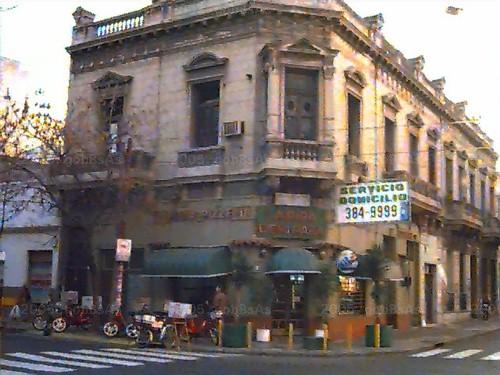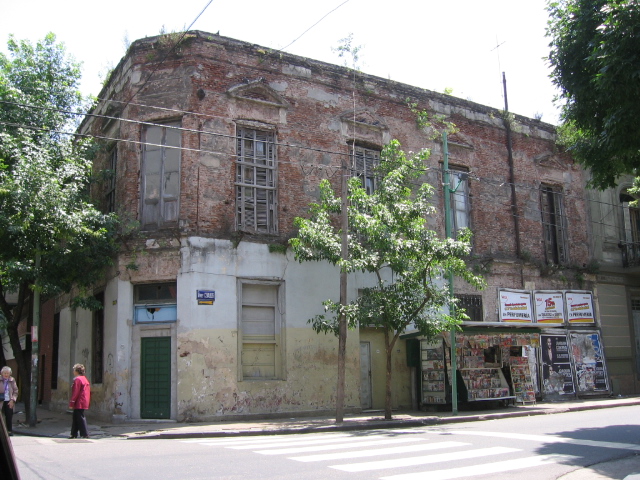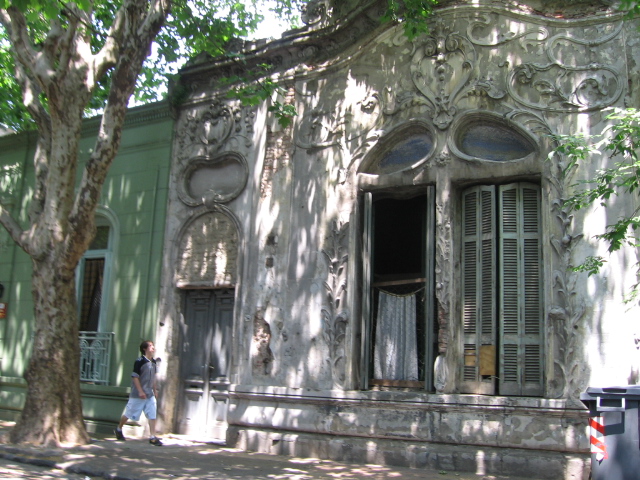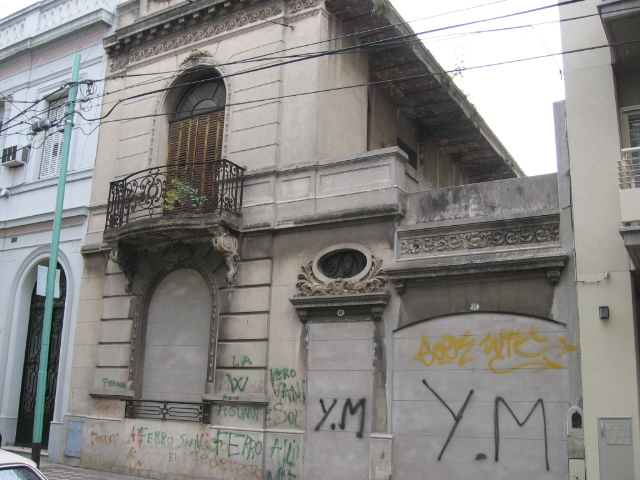January 2008
Monthly Archive
With the renovation of Teatro Colón behind schedule, which shouldn’t surprise anyone, the theater will not be ready for its 100th anniversary on May 25th. I also noticed that the Teatro Colón has a new web site, much nicer than the older one (though as of today the new site is still lacking a lot of information).
Let’s take a look back at the 1908 season of Teatro Colón, which was filled with productions.
Aida by Verdi
Performed: May 25, 26, & 28
Hamlet by Ambroise Thomas
Six performances starting on May 30
Madama Butterfly by Puccini
Five performances starting on June 4
Tristán e Isolda by Wagner
Performed: June 10, 12, & 20; July 2 & 7; August 8
Rigoletto by Verdi
Five performances starting on June 14
Tosca by Puccini
Three performances starting on June 16
La Gioconda by Amilcare Ponchielli
Five performances starting on June 24, including a gala performance for July 9.
Paolo y Francesca by Luigi Mancinelli
Performed: July 4 & 5, August 1
Mefistófeles by Arrigo Boito
Six performances starting on July 12
Otello by Verdi
Performed: July 18, 23, & 26; August 21
El Barbero de Sevilla by Rossini
Performed: July 28 & 30; August 16, 23, & 30
Ipagliacci by Ruggiero Leoncavallo
Performed: August 5, 11, & 25; September 11
Il Trovatore by Verdi
Performed: August 6, 9, 14, & 23; September 6
Cendrillon by Jules Massenet
Three performances starting on August 13
Don Giovanni by Mozart
Performed: August 18, 20, & 27
Sigfrido by Wagner
Performed: August 29 & 30; September 3 & 7
Aurora by Hector Panizza
Performed: September 5, 8, & 9
I promise to get back to some postings about things other than the city that fades away series. (I have an upcoming set of posts about opera in Buenos Aires). But here’s another place on Virrey Cevallos that I came across, this time in the corner of Constitución rather than Monserrat.

Okay, the building that it replaced (again courtesy of the city’s mapping site) was long neglected and the ground floor destroyed. What were they thinking? That ground floor looked like the entrance to a prison.

Certainly, demolition and building new was cheaper than attempting a restoration. Not only is it amazing at the rate that older structures are being torn down, it’s astonishing at the many beautiful residences that have become low-income housing.
Some people obviously look around Buenos Aires and see tremendous opportunity. A large population, crumbling buildings, cheap labor, and apparently little regulation make Buenos Aires a dream city for real estate developers. But, oh, if it could just be easier to kick the squatters out of those buildings and foreclosures could be more rapid then the lending market could take off, spurring even more construction, new homes, and …well, the economy here runs in cycles anyway.
To be fair, Buenos Aires – like everywhere – has gone through periods of building booms…note all those hideous apartment buildings that seem dated from the 1970s and 1980s. Perhaps most notably was the massive demolition of entire city blocks to create Av 9 de Julio, the diagonals, and let’s not forget, even Av de Mayo. Most of these lovely buildings of faded elegance replaced previous structures.
Will the new construction displace an essential character of the city, the architecture that currently distinguishes Buenos Aires from most other cities in the Western Hemisphere?
I just had a vision of the future of Buenos Aires: in an attempt to ease traffic congestion, an elevated highway is constructed above Av 9 de Julio.
Meanwhile in Monserrat
This new apartment building is going up at the corner of Virrey Cevallos and Chile. That’s actually a very good location if you want something in the center of the city.

But look closely at the edges of the neighboring building. Demolition crews do a sloppy job, leaving traces of the former structure. What was this places before?

Ceci actually used to live just down the street on Virrey Cevallos a few years back and I have actually walked this block many times back in 2003. Was there something there then or was it already gone? Honestly, I can’t even remember. Fortunately, the city’s mapping site reminds us with this photo from 1997:

I want to say that I remember this corner from 2003 but I’m not sure. Perhaps I’m mistaking it with some other similar corner. Well, perhaps Buenos Aires only needs one corner like this and the rest can go away … in this city that fades away.
Yes, it’s time for another entry in the City that Fades Away series.
On the way to the fish market Saturday I saw this building on Piedras that is getting prepped for demolition and the construction of something new.

It’s located right across the street from the entrance to the Grupo Clarín media empire, which already has taken over many of the buildings in this corner of Barracas. I wonder if it will be more Clarín offices or an even more unimaginative structure like this apartment building going up just two doors down, masquerading with the name Altos de Piedras:

(My research gladly shows that nothing noteworthy was at the spot of this new building).
Not all is lost on Piedras
At the end of the very same block of Piedras is this house that has undergone renovation.

Fortunately, it didn’t meet the fate of this other house further up Piedras.
One of my particular topics of interest is immigration to Argentina, particularly Eastern European, Jewish or Italian immigration but also from other countries (Irish, British, or I guess just about anywhere). I’m always interested in reading personal stories of immigration to Argentina.
As I was browsing the bookstores on Corrientes yesterday, I came across a book that is a fascinating history of Italians in Argentina, appropriately named Historia de los italianos en la Argentina.
 The book (almost 500 pages) is a scholarly study of the topic by Fernando Devoto, a history professor at the University of Buenos Aires who for more than 25 years has been researching Italian immigration to Argentina. Yet, the book is still very readable and informative for anyone interested in this topic.
The book (almost 500 pages) is a scholarly study of the topic by Fernando Devoto, a history professor at the University of Buenos Aires who for more than 25 years has been researching Italian immigration to Argentina. Yet, the book is still very readable and informative for anyone interested in this topic.
The book starts with the early migration under Rosas but focuses on the height of Italian immigration to Argentina in the late 1800s and early 1900s. An entire chapter is devoted to the institutions of the Italians in Argentina, e.g, the mutual associations, hospitals, and clubs. There are numerous short profiles of Italian-Argentine intellectuals, scientists, and professionals that contributed to the development of Argentina. Also, a section covers the role of Italians in the Argentine left, the workers movement, and anarchism. Later chapters cover the period between the two world wars (which includes a section on fascism and Italian communities in Argentina), and the last chapter is from 1945 to the present.
Last night I only had time to browse through the book and read a few sections but I’m really looking forward to reading more of it. As I progress through the book, I’ll post a few bits of relevant commentary to the blog. But if you’re Argentine-Italian or interested in Argentine history, then this is a good book for your collection.
Other posts related to the topic of Italian immigration to Argentina
At some point around two this morning I finally got around to reading this thoughtful essay by fellow San Telmo resident Marcelo Ballvé, The Literary Alchemy of César Aira.
Aira is certainly one of the leading voices in contemporary Argentine literature. In what is becoming a tradition among Argentine writers, Aira’s works are not at all traditional treatments of fiction. Marcelo tells us, “Like the storyteller of prehistory, Aira is concerned not so much with verisimilitude or realism as he is with that bewitching kernel of mystery that is at the heart of a narrative.”
Marcelo makes the case that Aira’s book “An Episode in the Life of a Landscape Painter is one of the great works of world literature from the last 25 years of the last century, as good if not better than W.G. Sebald or Roberto Bolaño.” That’s a pretty strong statement, particularly considering the Bolaño mania of the past year. (But Marcelo is far from being alone in his praise. The Aira novel was recognized as the most extraordinary book in translation of 2006).
Aira claims to never edit his works, which is a contrast to many writers (myself included) who believe that the art of writing is in the revisions. But Aira takes a refreshingly artistic approach to literature:
“The key to Aira’s curious career, I think, is to be found in his conception of literature as something with more affinities to the realm of action than the inner world of reflection. Literature is perhaps nothing more complicated and glorious than the act of writing and publishing, and publishing again and again. Editing is dispensable, so is the search for the “right” publisher.”
Someday when I want to think more about it, there are some intriguing aspects to Aira that foreshadow developments in new media and, perhaps, the future of literature. The lack of editing so that writing retains an always forward motion, a continuum, is today most clearly seen in blogging, a form of writing which is rarely self-edited and by its very chronological nature is in constant movement.
All of which makes me think that Aira would be one of hell of a blogger. (Does he have a blog?) Well, maybe if he was a few decades younger then he would be a blogging, Twittering fool. After all, is literature about writing or creating physical objects known as books?
I’ve started reading the blog Planet of the Blind by author Stephen Kuusisto, who has been “legally blind” since birth.
In a post titled “Spoons in the Snow“, Kuusisto describes attending the keynote address by Jorge Luis Borges at a conference on Nabokov in the late 1970s. Amusingly, it turns out that in the Q&A following Borges’ talk that Borges gave the impression that he had never heard of Nabokov. (It’s likely that Borges was simply toying with the Nabokov scholars.)
Writing is not another form of journalism
But the gem of Kuusisto’s post is not that anecdote but the lesson learned from Borges, or “How would I be able to write about the world if I couldn’t see it?”
“I thought some more about Borges.
A friend told me how his mother used to walk everyday in Buenos Aires with the poet. She would describe the things she was seeing in the central market and in turn Borges would narrate his version of their walk.
This emancipation from the photographic image is what allowed me to become a writer.
What a relief it is to write about the things I do not see!”
Went up to San Isidro to visit the home of Villa Ocampo, one of the homes of Victoria Ocampo. The Web site for Villa Ocampo is actually quite good and contains a lot of information that the woman who was a great patron of the arts

It’s a gorgeous house, certainly worth a visit.

If you can make it out to San Isidro, then stop by Victoria Ocampo’s house in Palermo….it’s a very different style.
One of my readers here in Buenos Aires, Dolores, sent me the following photos of abandoned or taken houses for the City that Fades Away series.

Catamarca y Humberto Primo
That cupola can’t last much longer, can it?
—

Cevallos y Humberto Primo
—

Mexico 2900
That window is a beauty.
—

Paysandu y Rivadavia
I’ve seen the exterior of this house myself and it’s wonderful. Notice that the windows and entrances are blocked over to keep people out otherwise empty houses become prime targets for squatters.





